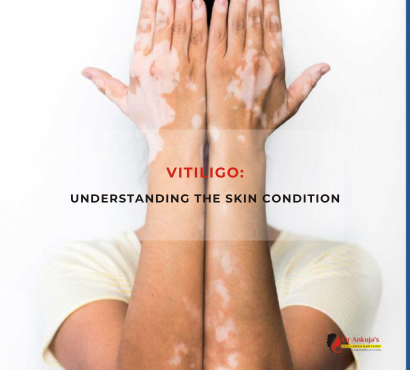Vitiligo is a chronic skin condition that causes loss of pigmentation, leading to white patches on the skin. It occurs when melanocytes (the cells responsible for skin color) stop functioning or die. While vitiligo is not contagious or life-threatening, it can significantly affect a person’s self-esteem and emotional well-being.
This blog covers:
✔ What causes vitiligo?
✔ Symptoms and types of vitiligo
✔ Available treatment options
✔ How to manage vitiligo effectively
Understanding vitiligo is the first step toward managing it. With advancements in dermatology, various treatment options can help restore pigmentation and improve quality of life.
What is Vitiligo?
Vitiligo is an autoimmune disorder that results in loss of skin pigment due to the destruction of melanocytes. This leads to the formation of white patches on different parts of the body, including the face, hands, feet, and even inside the mouth.
Vitiligo affects 1-2% of the global population, with India having one of the highest prevalence rates (up to 8% in some regions). It can occur at any age but commonly appears before the age of 30.
Types of Vitiligo
Vitiligo is classified based on the pattern and distribution of the white patches:
1. Non-Segmental Vitiligo (NSV) – Most Common
✔ Affects both sides of the body symmetrically (e.g., both hands, both knees).
✔ Progresses slowly over time.
✔ More likely to be genetically inherited.
2. Segmental Vitiligo (SV)
✔ Appears on one side of the body (localized to one area).
✔ Develops at an early age and progresses rapidly for a few years before stabilizing.
✔ Less common but more responsive to treatment.
3. Universal Vitiligo
✔ A rare form where over 80% of the skin loses pigment.
✔ Requires specialized management.
What Causes Vitiligo?
Although the exact cause is unknown, researchers believe that vitiligo is caused by a combination of genetic, autoimmune, and environmental factors.
1. Autoimmune Reaction
✔ The immune system mistakenly attacks melanocytes, stopping pigment production.
✔ Common in people with other autoimmune conditions (e.g., thyroid disorders, diabetes).
2. Genetic Factors
✔ Around 30% of vitiligo cases have a family history of the condition.
3. Environmental Triggers
✔ Emotional stress, sunburns, skin trauma, or exposure to chemical irritants may trigger vitiligo.
4. Neurogenic Causes
✔ Nerve-related issues may cause melanocyte dysfunction.
Symptoms of Vitiligo
The main symptom of vitiligo is the appearance of white patches on the skin, but other symptoms may include:
✔ Premature graying of hair on the scalp, eyebrows, eyelashes, and beard.
✔ Loss of pigment in the mucous membranes (inside the mouth, nose, and genitals).
✔ Color changes in the retina (inner eye).
✔ Increased sensitivity to sunlight in affected areas.
Diagnosis of Vitiligo
A dermatologist diagnoses vitiligo through:
✔ Physical Examination – Checking for white patches and affected areas.
✔ Wood’s Lamp Test – A special UV light used to detect vitiligo patches.
✔ Blood Tests – To check for autoimmune diseases like thyroid disorders.
✔ Skin Biopsy – Rarely done, but it can confirm the absence of melanocytes.
Treatment Options for Vitiligo
While there is no permanent cure, various treatments can help restore skin color and slow progression.
1. Topical Treatments
✔ Corticosteroid Creams – Help reduce inflammation and promote repigmentation (effective in early stages).
✔ Calcineurin Inhibitors (Tacrolimus, Pimecrolimus) – Useful for facial vitiligo and sensitive areas.
✔ Topical Psoralen + UVA (PUVA Therapy) – Stimulates melanocyte activity.
2. Phototherapy (Light Therapy)
✔ Narrowband UVB Therapy (NB-UVB) – Most effective for widespread vitiligo; requires multiple sessions.
✔ Excimer Laser Therapy – Targeted treatment for small areas.
3. Surgical Treatments
✔ Skin Grafting – Pigmented skin is transplanted to the vitiligo-affected area.
✔ Melanocyte Transplantation – Cultured melanocytes are injected into depigmented skin.
✔ Tattooing (Micropigmentation) – Used in small areas like lips or fingertips.
4. Natural and Home Remedies
✔ Dietary Changes – Foods rich in antioxidants, folic acid, and vitamin B12 may help.
✔ Psoralen-rich foods (figs, celery, parsley) – Used in traditional treatments.
✔ Aloe Vera & Coconut Oil – Help keep skin hydrated and reduce inflammation.
5. Lifestyle and Psychological Support
✔ Sun Protection – Always wear sunscreen (SPF 50+), hats, and protective clothing to prevent sunburn.
✔ Cosmetic Cover-ups – Use self-tanners or concealers for temporary camouflage.
✔ Mental Health Support – Vitiligo can impact self-esteem; joining support groups or seeking counseling may help.
When Should You See a Doctor?
Consult a dermatologist if:
✔ White patches spread rapidly.
✔ Vitiligo affects your confidence or emotional well-being.
✔ You have autoimmune disorders alongside vitiligo.
Vitiligo is a complex skin condition that requires a holistic approach to treatment. While there is no permanent cure, medical treatments, phototherapy, and lifestyle adjustments can help restore pigmentation and boost confidence.
If you or a loved one is affected by vitiligo, seeking timely medical advice can help manage symptoms effectively. Embracing self-confidence and awareness is key to overcoming societal stigma.
FAQ
1. Is vitiligo contagious?
No, vitiligo is not contagious. It is an autoimmune condition, not caused by infections.
2. Can vitiligo be prevented?
There is no guaranteed way to prevent vitiligo, but avoiding skin trauma, stress, and maintaining a healthy lifestyle may help slow its progression.
3. Does vitiligo get worse with time?
Vitiligo is unpredictable. In some cases, it may remain stable, while in others, it may spread over time. Early treatment can help slow progression.

